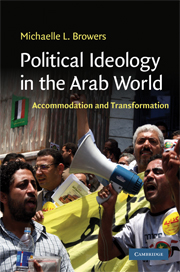Book contents
- Frontmatter
- Contents
- Acknowledgments
- Glossary
- Introduction: Ideological thought and practice in the Arab region
- 1 Retreat from secularism in Arab nationalist and socialist thought
- 2 A more inclusive Islamism? The wasatiyya trend
- 3 Framing a cross-ideological alliance
- 4 The Egyptian Movement for Change: Intellectual antecedents and generational conflicts
- 5 Yemen's Joint Meeting Parties: Origins and architects
- Conclusion: Ideological rapprochement, accommodation, transformation – and their limits
- Bibliography
- Index
- Cambridge Middle East Studies
Introduction: Ideological thought and practice in the Arab region
Published online by Cambridge University Press: 22 January 2010
- Frontmatter
- Contents
- Acknowledgments
- Glossary
- Introduction: Ideological thought and practice in the Arab region
- 1 Retreat from secularism in Arab nationalist and socialist thought
- 2 A more inclusive Islamism? The wasatiyya trend
- 3 Framing a cross-ideological alliance
- 4 The Egyptian Movement for Change: Intellectual antecedents and generational conflicts
- 5 Yemen's Joint Meeting Parties: Origins and architects
- Conclusion: Ideological rapprochement, accommodation, transformation – and their limits
- Bibliography
- Index
- Cambridge Middle East Studies
Summary
Arab nationalism and Islamism have proven two of the most potent ideological forces in the Arab region over the past century. On the one hand, the two trends would seem to possess a number of natural affinities. Muslims are keenly aware of the central role played by Arabs and Arabic in the development of Islamic civilization. In the words of the founder of the Muslim Brotherhood, Hasan al-Banna (1906–1949): “Islam arose among Arabs and reached other nations through the Arabs. Its noble book is in Arabic. It is found in the traditions that ‘when Arabs are denigrated, Islam is denigrated … Arabs are the guardians of Islam’.” So too, Arab nationalists have acknowledged the special place Islam occupies in Arab civilization: not only is Islam the religion of the vast majority of Arabs, but Islam's golden age corresponds with one of the most celebrated periods in Arab history. Ba'th Party founder Michel ‘Aflaq (1910–1989) affirmed this relation in claiming that “Islam … was an Arab movement and its meaning was the renewal and completion of Arabism.”
However, even when Arab nationalists and Islamists have found themselves facing a common enemy – such as corrupt and authoritarian regimes that seek their marginalization or suppression – they have most commonly proven to be each other's worst enemy. Throughout the contemporary period their relationship has been better characterized as competitive and hostile than as cooperative and complementary, as each of the two ideologies has fought for pride of place in the hearts and minds of people in the region.
- Type
- Chapter
- Information
- Political Ideology in the Arab WorldAccommodation and Transformation, pp. 1 - 18Publisher: Cambridge University PressPrint publication year: 2009



